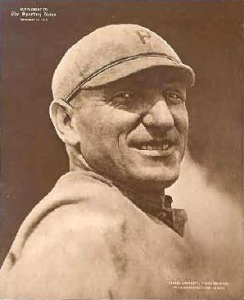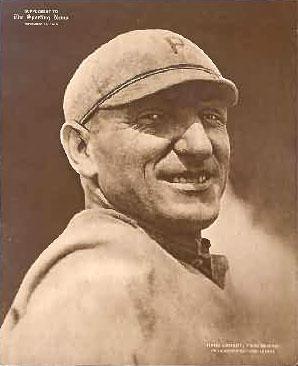Hans Lobert
 Hans Lobert’s game was built around speed. Aside from 1912, when an injury caused him to miss more than half the season, the stocky, bowlegged third baseman stole 30 or more bases each year from 1907 to 1914. At a field day in Cincinnati on October 12, 1910, Lobert rounded the bases in 13.8 seconds, considered a record at the time. He also raced against—and defeated—Olympic gold-medal winner Jim Thorpe, collegiate track-star Vince Campbell, and even a racehorse. One reporter suggested that if Hans put his mind to it, he could be the world-record holder in the 110 and the 440. But the hardnosed Lobert was far from one-dimensional. The lifetime .274 hitter batted over .300 four times and twice led National League third basemen in fielding percentage.
Hans Lobert’s game was built around speed. Aside from 1912, when an injury caused him to miss more than half the season, the stocky, bowlegged third baseman stole 30 or more bases each year from 1907 to 1914. At a field day in Cincinnati on October 12, 1910, Lobert rounded the bases in 13.8 seconds, considered a record at the time. He also raced against—and defeated—Olympic gold-medal winner Jim Thorpe, collegiate track-star Vince Campbell, and even a racehorse. One reporter suggested that if Hans put his mind to it, he could be the world-record holder in the 110 and the 440. But the hardnosed Lobert was far from one-dimensional. The lifetime .274 hitter batted over .300 four times and twice led National League third basemen in fielding percentage.
The son of a cabinetmaker, John Bernard Lobert was born in Wilmington, Delaware, on October 18, 1881. The family eventually included six children, and John’s brothers Frank Lobert and Ollie also played professional baseball. After moving to Williamsport, Pennsylvania, the Loberts eventually relocated to the Pittsburgh area where John began playing for the Pittsburgh Athletic Club. After a 1903 game in Atlantic City, New Jersey, vacationing Pittsburgh Pirates owner Barney Dreyfuss invited Lobert to try out for his team that September. When John showed up in the clubhouse at Exposition Park, Honus Wagner found out that they lived near each other, that they shared the same name (Johannus in German, which was their common heritage), and perhaps recognized that they bore a slight facial resemblance to each otherespecially in their prominent noses. The great Pirates star dubbed the 21-year-old rookie “Hans Number Two,” and called him that for the next 50 years.
The nickname stuck . . . but Lobert didn’t. Having long since clinched the pennant, Pittsburgh manager Fred Clarke tried him out at every position in the infield except first base. Hans appeared in five games for the Pirates that fall, making three errors and only one hit in 13 at-bats. He described his lone hit in The Glory of Their Times. According to the story, late in a game against Joe McGinnity of the New York Giants, with two strikes against him, Lobert bunted for a single. When he took his position at third base, John McGraw, who was coaching third for the Giants, asked him who taught him to bunt with two strikes. “Nobody did,” Lobert replied, “but I like to bunt and nobody was looking for a busher to do that.” McGraw responded, “Well, you keep it up. That’s the way to keep them on their toes.”
The Pirates decided Lobert needed more seasoning so they sold him to Des Moines, Iowa, of the Western League. He played 143 games in 1904 and batted .264 with 37 stolen bases. That winter the Des Moines team changed hands and the new owner offered Lobert a contract with a substantial cut in pay. Spurning the offer to play closer to home, Hans signed on with Johnstown of the outlaw Tri-State League and batted .337 with 31 stolen bases in 115 games.
Late in the 1905 season the Chicago Cubs purchased Lobert’s contract from Des Moines, which still held his rights in organized baseball. Hans batted .196 in 14 games with the Cubs, which leads to another tale he sometimes told of his first meeting with McGraw. According to this story, Lobert stole second base, sliding hard into Giants shortstop Bill Dahlen. The two began to argue and nearly came to blows. After the inning, when Hans returned to his position at third base, McGraw told him, “Don’t let them bluff you, young fellow. Hold your ground.” Lobert did just that. Innings later Mike Donlin slid into him, spiking him in the leg. Hans shrugged it off, but moments later he tagged Donlin out on a pickoff, spiking him as he placed the tag.
Just before the start of the 1906 season, the Cubs sold Lobert to the Cincinnati Reds. “If that trade hadn’t been made, it would have been Frank Chance, Johnny Evers, Joe Tinker, and Lobert, I guess,” Hans surmised. Even though the competition wasn’t quite as stiff with the Reds, he became a utility man, batting .310 with 20 stolen bases in 79 games—35 at third base, 31 at shortstop, and 10 at second base. In 1907 Lobert replaced the ancient Tommy Corcoran as the everyday shortstop, batting .246 with a team-high 30 stolen bases. After starting the 1908 season at shortstop again, he moved in midseason to third base, the position he played for the rest of his career. Soon Hans established himself as one of the NL’s young stars.
Playing in all 155 games, the 26-year-old Lobert led Cincinnati in just about every offensive category in 1908: batting average (.293), at-bats (570), runs (71), hits (167), doubles (17), triples (18), home runs (4), RBIs (63), and a career-high 47 stolen bases. The next season the Reds pilfered 280 bases, running away with the National League lead in that category, but Hans slumped to a .212 batting average and only 30 steals, finishing fourth on the club behind Bob Bescher (54), Dick Egan (39), and Mike Mitchell (37). The Reds increased their league-leading stolen-base total to 310 in 1910. Despite appearing in just 93 games due to a back injury, Hans batted .309 and contributed 41 steals, tied with Egan for third on the club behind Bescher (70) and Dode Paskert (51).
In November 1910 the Reds sent Lobert to the Philadelphia Phillies as part of an eight-player trade. In 1911 batted .285 and led the Phillies with 40 stolen bases. Lobert endured another injury-plagued campaign in 1912, increasing his batting average to a career-high .327 but appearing in just 65 contests.
Probably his best year, both off and on the field, was 1913. Hans married Philadelphia resident Rachael Campbell that year and defeated Jim Thorpe in a 100-yard dash at the Polo Grounds. He also played in all but one of the Phillies’ 151 games, batting an even .300, leading all NL third basemen in fielding percentage (.974), and ranking third in the NL in runs (98) and stolen bases (41) and fourth in hits (172) and total bases (243).
That 1913 season proved to be the apex of Hans Lobert’s playing career. After one more decent season in Philadelphia—he batted .275 in 135 games and led NL third basemen again with a .943 fielding percentage—Lobert went to Chicago with the intention of signing a contract with the Federal League’s Chicago Whales. There he ran into his old friend John McGraw, with whom he had barnstormed around the world during the offseason of 1913. McGraw convinced him not to sign with the Feds, then acquired him from the Phillies in January for pitcher Al Demaree, young third-baseman Milt Stock, and reserve catcher Bert Adams. The Giants gave Lobert a three-year contract, matching the money the Feds had offered him. It turned out to be a steep price to pay for a player whose best days were behind him. Lobert batted .251 as the regular third baseman in 1915 but tore ligaments in his knee, ending his season after only 106 games. He struggled for two more years, finally calling it quits when his contract expired in 1917.
With McGraw’s assistance, Lobert received an appointment as baseball coach of the US Military Academy at West Point, where he remained for eight years. He then became a full-time scout for McGraw, and in 1928 he joined the Giants as a coach. The following year Lobert became the manager of Bridgeport of the Eastern League, leading the team to three consecutive second-place finishes. In 1932 he took the helm of Jersey City of the International League. Returning to Philadelphia in 1934, Lobert worked as a Phillies coach until 1942, when he spent one year as the team’s manager. He was determined to mold the team in his own image, and the Phillies even shortened their name to the more streamlined “Phils” to add some dash, but they still finished last in the NL in both stolen bases and victories. Lobert coached for the Reds for two seasons, then returned to the Giants.
When Connie Mack died in 1956, Hans Lobert became the man who had been in major-league baseball longer than anybody else. He continued to scout and work as an instructor for the Giants until his death in Philadelphia at age 86 on September 14, 1968.
Note: A slightly different version of this biography appeared in Tom Simon, ed., Deadball Stars of the National League (Washington, D.C.: Brassey’s, Inc., 2004).
Sources
For this biography, the author used a number of contemporary sources, especially those found in the subject’s file at the National Baseball Hall of Fame Library.
Full Name
John Bernard Lobert
Born
October 18, 1881 at Wilmington, DE (USA)
Died
September 14, 1968 at Philadelphia, PA (USA)
If you can help us improve this player’s biography, contact us.


